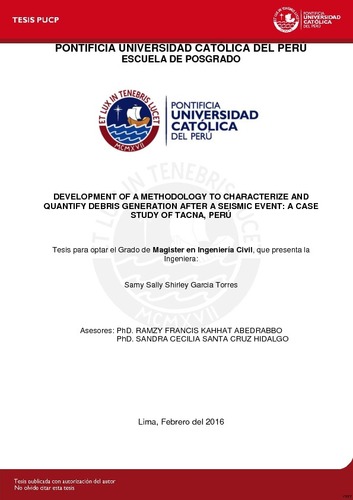| dc.contributor.advisor | Kahhat Abedrabbo, Ramzy Francis | |
| dc.contributor.author | García Torres, Samy Sally Shirley | es_ES |
| dc.date.accessioned | 2016-06-30T20:04:44Z | es_ES |
| dc.date.available | 2016-06-30T20:04:44Z | es_ES |
| dc.date.created | 2016 | es_ES |
| dc.date.issued | 2016-06-30 | es_ES |
| dc.identifier.uri | http://hdl.handle.net/20.500.12404/7056 | |
| dc.description.abstract | Earthquakes are natural phenomena that can cause severe damage to civilian infrastructure and prolonged disruption to society. Depending on their magnitude, epicenter location, infrastructure characteristics, and many other features, earthquakes may generate large amounts of debris and waste. The large amounts of debris generated after the disaster become one of the main problems for a population facing a health issue and rapid reconstruction of the city. A proper characterization and quantification of debris and subsequent waste management and reconstruction plan is essential for the restoration of an area affected by an earthquake. This study presents a methodological approach to characterize and quantify the debris produced as a consequence of earthquakes, as well as the flow of materials required for the reconstruction of the area affected. The proposed methodology includes an infrastructure characterization stage, a probabilistic estimation of damage by characterizing the vulnerability functions using CAPRA-GIS tool, and material flow analysis (MFA) for the characterization and quantification of debris associated with the event of an earthquake and new materials for the reconstruction stage. A case study was developed to test this methodological approach. The residential sector of Tacna, a city with high seismic risk located on the southern coast of Peru, was selected. Moreover, five different construction systems (i.e. Reinforced Masonry Bearing Walls with Concrete Diaphragms, Adobe, Wood, Concrete Shear Walls and Straw) presented in the residential sector of Tacna were characterized. Also three possible earthquake scenarios (i.e. 8.6 Mw., 7.5 Mw. and 6.2 Mw.) were analyzed, each one with three different end-of-life management situations. Simultaneously, the origin and quantities of new materials needed for the reconstruction of civil infrastructure were determined. The flow of new materials considered productivity rates in the construction and manufacturing sectors. The results show that in the presence of the greater earthquake (8.6 Mw.), adobe and straw homes suffered greater damage, with damage percentages of 63 and 48, yielding 27000 tonnes and 1390 tonnes of debris, respectively. Also, 204,000 tonnes of concrete, 7,400 tonnes of steel and 461,400 tonnes of clay brick were included as debris generated in this scenario.
Furthermore, for all scenarios, the MFA estimates a regional import of materials (e.g. cement, steel, brick and wood) for the reconstruction phase. The following methodology is applicable to developed and undeveloped countries with different housing types, their respective vulnerability functions and constant earthquake recurrence. | es_ES |
| dc.description.uri | Tesis | es_ES |
| dc.language.iso | eng | es_ES |
| dc.publisher | Pontificia Universidad Católica del Perú | es_ES |
| dc.rights | info:eu-repo/semantics/closedAccess | es_ES |
| dc.subject | Edificios--Efectos sísmicos--Perú--Tacna. | es_ES |
| dc.subject | Sismología--Estudio de casos--Perú--Tacna. | es_ES |
| dc.title | Development of a methodology to characterize and quantify debris generation after a seismic event : a case study of Tacna, Perú | es_ES |
| dc.type | info:eu-repo/semantics/masterThesis | es_ES |
| thesis.degree.name | Maestro en Ingeniería Civil | es_ES |
| thesis.degree.level | Maestría | es_ES |
| thesis.degree.grantor | Pontificia Universidad Católica del Perú. Escuela de Posgrado | es_ES |
| thesis.degree.discipline | Ingeniería Civil | es_ES |
| renati.advisor.dni | 08746262 | |
| renati.discipline | 732267 | es_ES |
| renati.level | https://purl.org/pe-repo/renati/level#maestro | es_ES |
| renati.type | http://purl.org/pe-repo/renati/type#tesis | es_ES |
| dc.publisher.country | PE | es_ES |
| dc.subject.ocde | https://purl.org/pe-repo/ocde/ford#2.01.01 | es_ES |





